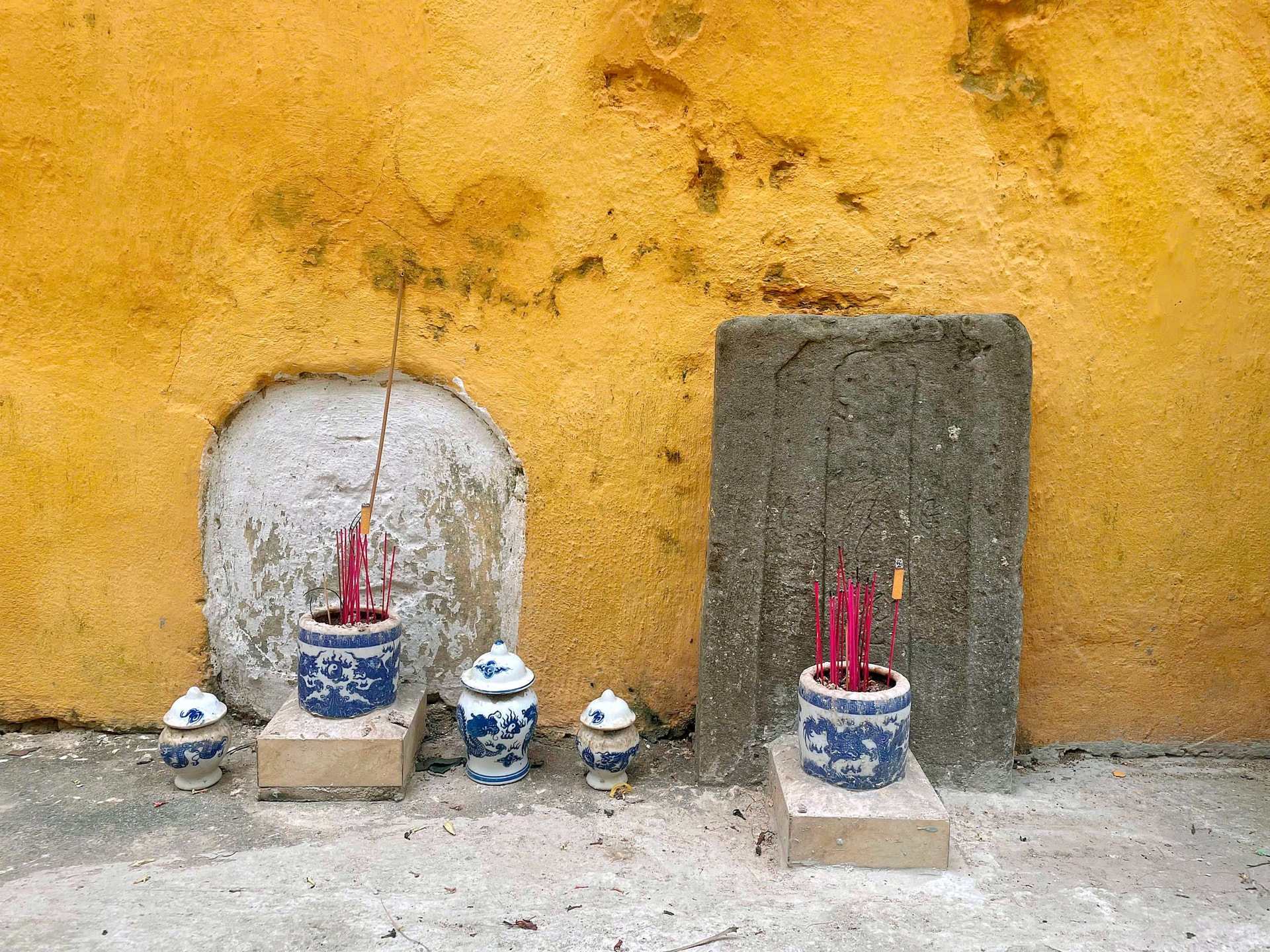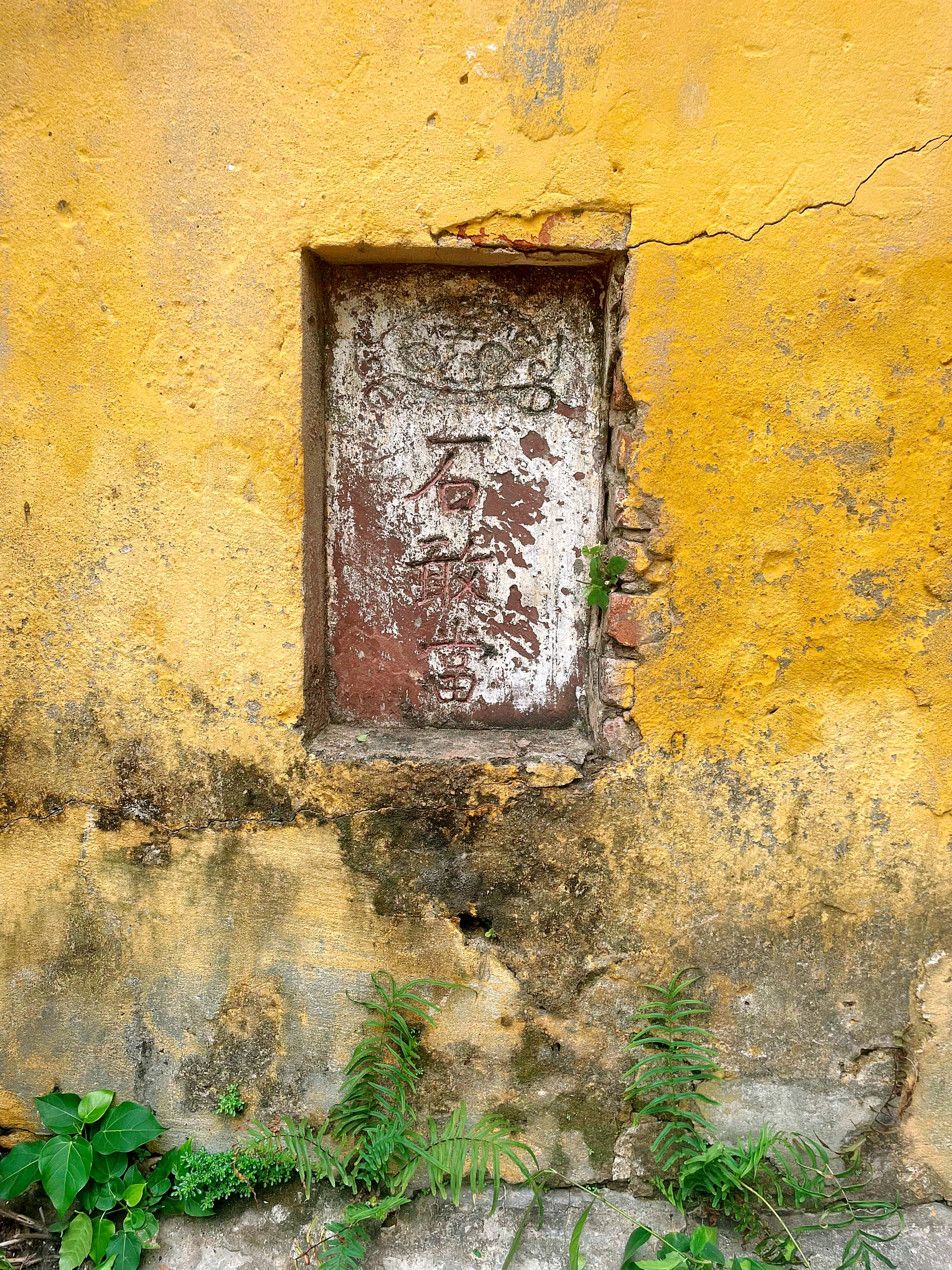
Along with the unique features present in every corner of the street, if you look a little more closely, you will see a few stone tablets nestled in the corner of a small alley or under an old tree, simple in form but containing interesting historical and cultural values.
Some popular forms of exorcism and house protection
When visiting Hoi An ancient town, tourists will see some houses hanging symbolic objects such as mirrors painted with the shape of a bagua, cactus branches... hanging in some positions in the architectural works that people believe can prevent bad luck.
Or many wooden houses have a pair of door eyes right above the main entrance door in the middle of the house. The door eyes have various shapes and colors, carved with the image of yin and yang in the center; the rim surrounding the center is carved with the image of a bagua. In addition to being an architectural detail, the door eyes also have a decorative function and carry spiritual elements.
People in the old town consider the door eye as a protective object, helping to prevent evil spirits from entering the house, helping the homeowner avoid misfortune, risks, business failures, and have a peaceful and happy life.
The largest and most important protective structure in Hoi An ancient town, known to many people, is the Japanese Covered Bridge. In addition to its function as a traffic bridge and a place to practice religion (worshiping the Northern Emperor Tran Vo), the relic is also believed to have the function of suppressing the Cu (according to ancient beliefs) to prevent floods and landslides, protecting the peaceful life of local people.
In addition to the above forms, in Hoi An ancient people also used stone steles to suppress evil spirits. Those who often wander in the alleys and lanes in the old town will occasionally come across a few stone steles of modest size, but few people understand the meaning of these steles.
Follow the stone tablet...
On the fence of the Le Doan clan temple (No. 44/20 Phan Chau Trinh), in front, on both sides of the entrance gate (main gate), there are two stone steles mounted on the fence, engraved with Chinese characters, painted white, in front of the steles is an incense burner for worship very solemnly.

In front of the left stele (looking from inside the house) there is also a sandstone stele, engraved with Chinese characters and drawings. The characters on the stele are faded and cannot be read clearly, but it can be confirmed that it is a suppression stele. In the middle of the stele, vertically, there are three Chinese characters engraved. The first character could be 勅 (color), the second character is 魂 (soul) or 鬼 (ghost), and the last character is 鎭 (town).
On the outside of the northern boundary wall (adjacent to the corner of the concrete alley) behind house number 19 Le Loi, there is a small rectangular stone stele, attached to the wall niche, with a drawing of an animal head (tiger?) on top and three characters engraved below: 石 敢 當 (Thạch Cảm Đường), making many people curious about its meaning. In addition to this stele, there is another Thạch Cảm Đường stele being kept at the Museum of Folklore (number 33 Nguyen Thai Hoc).
This is a form of protection brought by the Chinese when they came to do business in Hoi An. Thach Cam Duong (meaning a stone that can resist everything), full name is "Thai Son Thach Cam Duong".
In ancient times, the Chinese believed that the rocks of Mount Tai had spiritual and divine powers.
According to legend, during the Han Dynasty, Emperor Wu of Han went up Mount Tai and brought back four stones, placing them at the four corners of the palace to ward off evil forces and bring blessings to the country. Gradually, people saw it as a god with the ability to ward off evil spirits, control water, avoid disasters, and pray for peace.
The “Thạch Cầm Đường” stele has different shapes in different places, some are round, some have reliefs like lion and tiger heads on top, or are accompanied by a bagua image. Some stele have no decoration, only engraved with the three words “Thạch Cầm Đường”.
This stele is often placed in the house, on the wall or at roads and intersections with feng shui conflicts to ward off evil spirits and limit disasters.
Many people believe that exorcism is a superstitious practice, seeking inner comfort when facing difficulties and disasters in life. However, from another perspective, exorcism can be seen as a form of folk belief.
The talisman represents the existence of divine power, is an intermediary connecting gods and humans, conveying human desires and aspirations in life.
Amulets, in any form, are a legacy left by the ancients and passed down through many generations, expressing simple and basic wishes for peace, goodness, and avoidance of misfortune and evil.
Source: https://baodanang.vn/bia-da-tran-yem-o-hoi-an-3299042.html


































![[Photo] Prime Minister Pham Minh Chinh receives Secretary of Shandong Provincial Party Committee (China) Lin Yu](https://vphoto.vietnam.vn/thumb/1200x675/vietnam/resource/IMAGE/2025/9/26/821396f0570549d39f33cb93b2e1eaee)





































































Comment (0)